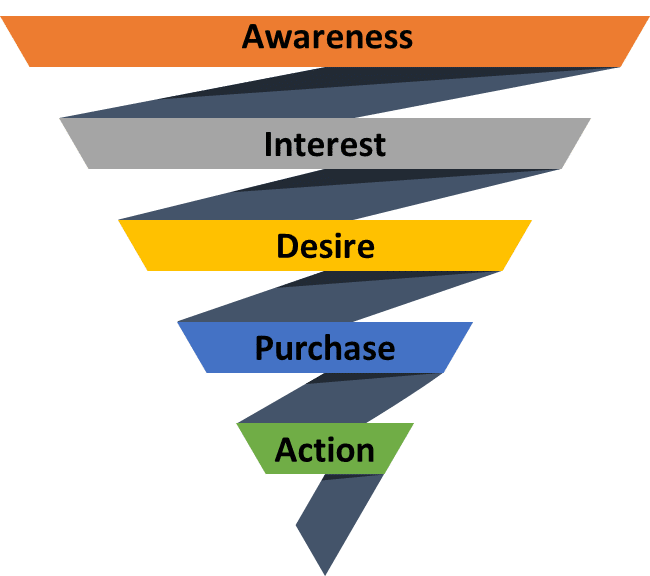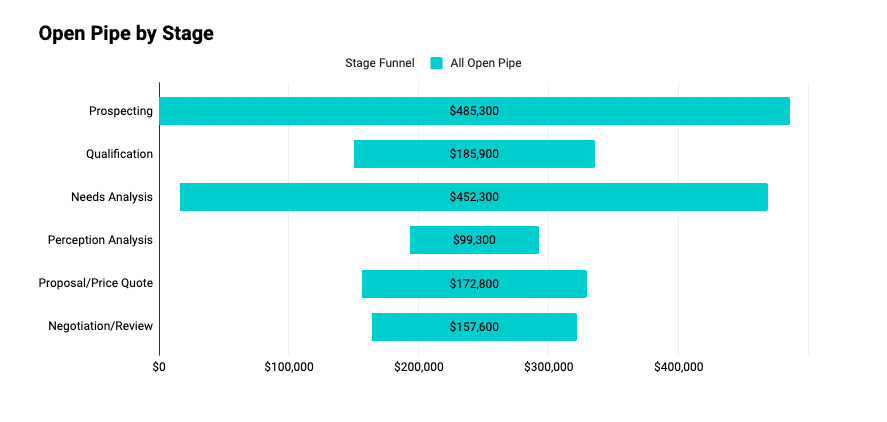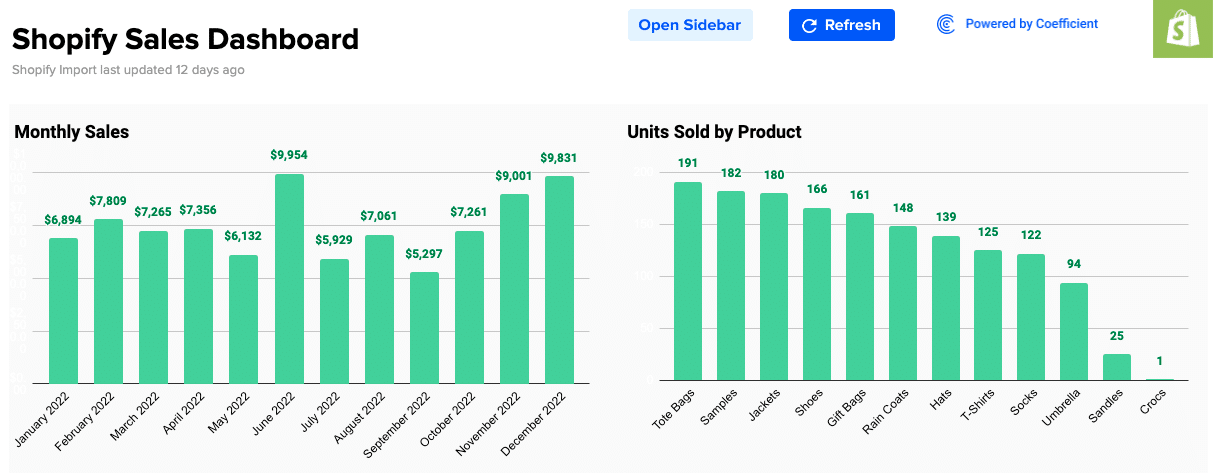In the fast-paced world of B2B Sales, careful management of the sales funnel is crucial to success. Companies need tools that streamline these processes and provide a holistic view of their sales pipelines. This is where templates that visualize the sales funnel come into play.
Dive into this blog to explore a few free sales funnel templates that will bring your sales data to life.
What is a Sales Funnel?
A sales funnel illustrates the customer journey, starting from the initial interaction at the top of the funnel to the culmination in a purchase. This model aims to shepherd as many potential customers as possible through each stage, transitioning them from mere prospects to paying customers.
By delineating the buying process from the first spark of interest to the final transaction, the sales funnel offers businesses a systematic method to nurture leads and transform them into loyal customers.
In contrast, a marketing funnels address the broader customer journey from the time a person becomes aware of a product to the purchase. It includes strategies that attract, engage, and nurture potential customers, employing marketing strategies like content marketing, email marketing, etc. to guide prospective customers to the next stage of the funnel.
Benefits of Using a Sales Funnel
1. Structured Approach to Lead Generation and Conversion
A sales funnel provides a structured pathway to manage prospective customers through which leads progressBy categorizing leads into different stages, such as awareness, consideration, and decision, sales reps can systematically guide them through each phase of the buying process.
This structured approach prevents potential customers from falling through the cracks. Every lead is assigned a specific stage, making it easier for sales and marketing teams to understand the lead’s current position in the buying journey. This systematic arrangement allows businesses to deploy targeted strategies and resources to nurture and convert leads effectively.
2. Clear Visibility into Lead Progress
One of the key advantages of an effective sales funnel is the transparent visibility it offers into the lead’s progression. Throughout each stage of the funnel, businesses can monitor and track the movement of leads from one phase to the next. This visibility is particularly valuable in optimizing email strategies, allowing for insights into the performance of follow-up emails and landing pages.
Understanding how leads progress enables businesses to identify top-performing stages and pinpoint areas that require improvement. Armed with this understanding, making prompt adjustments becomes an integral part of ensuring that the journey of qualified leads through the funnel remains both effective and efficient. This level of insight holds immense value, particularly for SaaS businesses. In this context, precise tracking and optimization of sales processes are of the utmost importance.
3. Informed Decision-Making
Sales funnels incorporate automation beyond lead tracking; they yield precious insights driving strategic decision-making. Progressing through distinct stages, leads generate a trove of data concerning their interactions, preferences, and behaviors. This data serves as a crucial wellspring for businesses, aiding in informed decision-making processes that positively impact the bottom line.
For instance, the analysis of conversion rates within each stage unveils the precise junctures where drop-offs manifest. Armed with this awareness, teams can channel efforts into refining content, messaging, or offers specific to those stages, thereby amplifying conversions.
Furthermore, insights from the funnel enable businesses to allocate resources smartly, optimizing both time and budget distribution, enhancing brand awareness and effectively navigating the buyer’s journey. These insights are particularly valuable when optimizing a checkout page, ensuring a seamless transition from interest to conversion.
4. Customer-Centric Approach
Sales funnels inherently prioritize the customer’s journey and experience. By mapping out the stages a lead goes through, businesses can tailor their communication and engagement strategies according to the specific needs of each stage.
Different Sales Funnel Stages
A typical sales funnel consists of several stages, each representing a specific phase of the customer journey. These stages can vary slightly depending on the nature of your business, but they generally follow the AIDA model: Awareness, Interest, Desire, and Action.

Awareness
At this stage, potential customers become aware of your product or service through various marketing efforts. This could involve encountering your brand through advertisements, content marketing, social media, or word-of-mouth recommendations. The primary goal of the awareness stage is to capture the attention of your target audience and make them aware of your existence and what you offer.
In this phase, it’s crucial to establish a compelling initial connection. Crafting your marketing materials to be both engaging and informative is essential, tailoring them to directly address your audience’s specific needs.
Interest
During the interest stage, prospects transition from simply being aware of your offering to displaying active interest in it. This is the critical phase when potential customers begin delving deeper, actively seeking more detailed information about your product or service. They might explore your website, dive into blog posts, watch videos, or interact with your social media content to gain a better understanding of what you provide.
To nurture this interest, provide valuable and informative content that addresses your audience’s pain points and offers solutions. Highlight the unique benefits and features of your offering that set you apart from competitors. Building interest encourages potential customers to stay engaged and learn more about how your product or service can meet their needs.
Desire
As prospects progress to the desired stage, they begin to develop a genuine desire for your product or service. This stage is all about helping them understand the value and relevance of what you offer. Potential customers should feel that your solution aligns with their specific needs and can provide them with the desired outcomes.
To create desire, showcase real-world examples, success stories, and testimonials from satisfied customers. Provide detailed information about how your product or service can solve their problems or enhance their lives.
Action
The ultimate stage of the sales funnel is action, where prospects initiate tangible interactions with your brand. This could encompass executing a purchase, enrolling in a complimentary trial, joining your email list, or soliciting further information. The crux lies in optimizing the process, streamlining the journey for potential customers to effortlessly embrace the desired functionality.
At this juncture, it becomes imperative to present lucid and compelling calls to action (CTAs). Guarantee that the steps leading to conversion are both uncomplicated and instinctive. Address any qualms or hesitations prospective customers might harbor and furnish the data requisite for a well-founded decision.
This approach holds true whether you’re facilitating engagement through channels like LinkedIn, email campaigns, phone calls, or capitalizing on an enticing lead magnet to fortify conversion rates.
B2B Sales Funnel vs. B2C Sales Funnel
While the core concept of a sales funnel remains consistent, there are notable differences between Business-to-Business (B2B) and Business-to-Consumer (B2C) sales funnels. Let’s compare them side by side:
| Aspect | B2B Sales Funnel | B2C Sales Funnel |
| Audience | Targeted towards businesses and organizations. | Targeted towards individual consumers. |
| Decision-Makers | Involves multiple decision-makers within a company. | Involves individuals or small groups. |
| Sales Cycle | Longer sales cycle due to complex decision-making. | Shorter sales cycle with quicker purchasing decisions. |
| Relationships | Focus on building long-term, professional relationships. | Focuses on creating emotional connections and impulse buying. |
Sales Funnel Template Examples
Understanding the importance of coefficients in optimizing sales funnels, let’s delve into practical examples of sales funnel templates.
Note: Coefficient offersfree sales funnel templates for HubSpot and Salesforce designed to streamline your lead nurturing process, enhance conversion rates, and optimize your sales strategy.
1. B2B Sales Funnel Template
The B2B Sales Funnel Template offers a comprehensive view of your pipeline, making it easier to manage and prioritize leads effectively. It streamlines lead management, opportunity tracking, and deal progression within the B2B context.
Key metrics tracked include:
- Lead Volume: Total count of individuals or businesses that show interest in your product or service and enter the top of the sales funnel.
- Lead Conversion Rate: The percentage of leads that progress to the next stage in the sales funnel
- Win Rate: The percentage of opportunities that successfully convert into sales, calculated as (Number of successful sales / Total opportunities) x 100.
- Average Deal Size: The average value of each sale or contract, calculated as the total revenue from sales divided by the number of successful sales.
2. Sales Funnel Template by B2B Pipeline Stages Template

The Sales Funnel Template by B2B Pipeline Stages offers a visual representation of how leads progress through the pipeline and where potential drop-offs occur. This information can guide your efforts to optimize conversion rates at each stage of the sales process.
Key metrics tracked include:
- Pipeline Creation: Measures the number of new leads entering the sales pipeline within a set time frame, indicating lead generation effectiveness.
- Win Rates: Calculates the percentage of leads that convert into sales, reflecting the efficiency of the sales process.
- Average Opportunity Size: Represents the average value of each potential deal, helping prioritize larger opportunities.
- Sales Velocity: Assesses how quickly leads move through the sales pipeline, highlighting the pace of revenue generation.
3. B2C Shopify Sales Funnel Template

The B2C Shopify Sales Funnel Template provides insights into your customer’s journey. Identify and improve key touchpoints to boost retention and conversion. Improve your online store’s results, enhance customer interactions, and boost your digital sales.
Key metrics tracked include:
- Website Engagements: Stay informed about the influx of visitors gracing your online emporium.
- Product Engagement: Gain insights into which products or services are capturing the attention of potential patrons.
- Cart Additions: Monitor the frequency of items being added to virtual shopping carts.
- Checkout Progress: Track the pivotal juncture where potential buyers proceed to finalize their purchases.
- Successful Transactions: Seamlessly record triumphant transactions that contribute to your revenue stream.
Consulting Business Sales Funnel Template
Consulting Sales Funnel Templates are meticulously crafted for consultants and consulting firms. They streamline the process from lead acquisition to project completion, ensuring every opportunity is maximized.
Key metrics tracked include:
- Lead Management: Capture and categorize potential clients expressing interest in your expertise.
- Appointment Coordination: Simplify the process of scheduling consultations, avoiding overlaps and ensuring timely interactions.
- Proposal Tracking: Monitor the status of proposals dispatched, ensuring timely follow-ups and adjustments as needed.
- Conversion Monitoring: Gain insights into how many proposals transition into concrete projects, helping in refining your proposal strategy.
- Project Oversight: Keep a pulse on ongoing projects, ensuring they’re on track and client expectations are met.
Tips to Optimize Your Sales Funnel
1. Segment Your Audience
Dividing your audience into segments allows you to tailor your approach and messaging for higher relevance. Not all leads are the same; they have varying needs, preferences, and pain points. By segmenting your audience based on demographics, behaviors, interests, or purchase history, you can create more personalized and targeted communication strategies.
2. Implement Lead Nurturinng
Lead nurturing involves engaging with leads over time through targeted content, nurturing their interest, and building trust. Not every lead is prepared to make an immediate purchase. Some might be in the early stages of research, while others might need more information before committing.
To nurture leads effectively, provide them with valuable content that addresses their needs and concerns. This content can include blog posts, ebooks, webinars, and case studies.
3. Optimize Call To Actions
Clear Calls to Action (CTAs) are essential for guiding leads toward the desired action. A CTA is a prompt that encourages users to take a specific action, such as signing up for a newsletter, downloading a resource, or making a purchase.
CTAs should be easily visible, compelling, and strategically placed throughout your marketing materials. CTAs should also be aligned with the stage of the funnel and the content that accompanies them.
4. Make Data-Driven Optimizations
Using analytics to identify weak points in your funnel enables data-driven improvements. Tracking and analyzing key metrics at each stage of the funnel provides insights into where potential customers are dropping off and what might be causing friction. This data empowers you to make informed optimization decisions.
Bring Your Data to Life with Sales Funnel Templates
Leveraging the right sales funnel templates can profoundly transform your sales approach and outcomes. It’s essential to understand that optimization is a continuous journey. With the right techniques and tools at your disposal, you can perpetually fine-tune your sales funnel to achieve unparalleled success.
By integrating these strategies and templates, you not only elevate your sales performance but also gain a deeper insight into your customer’s preferences and behaviors.
Try Coefficient for free to see how our free sales funnel templates can help elevate your sales strategy.



